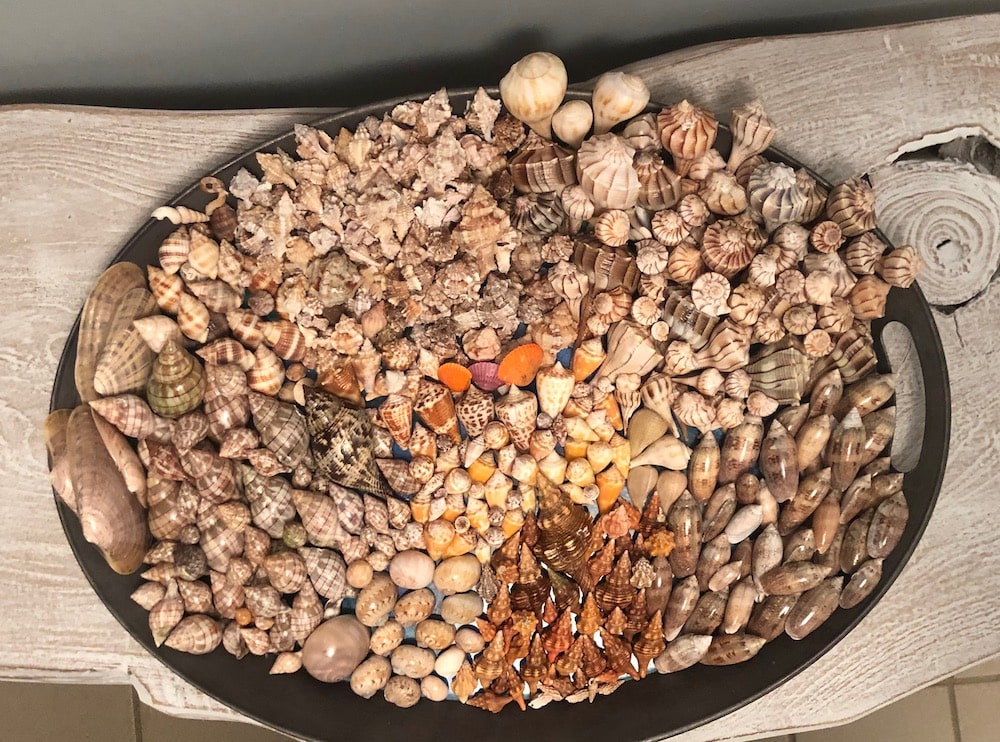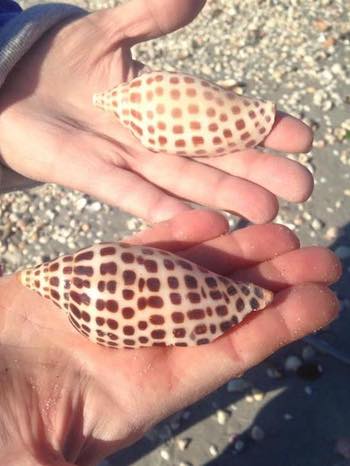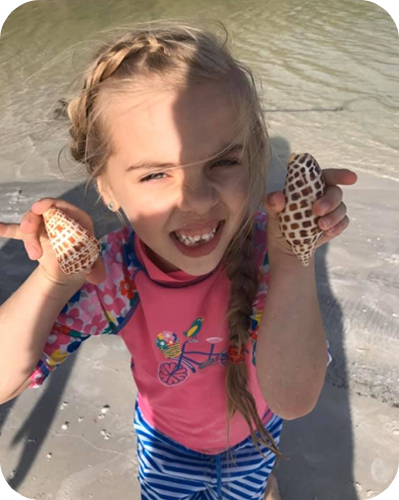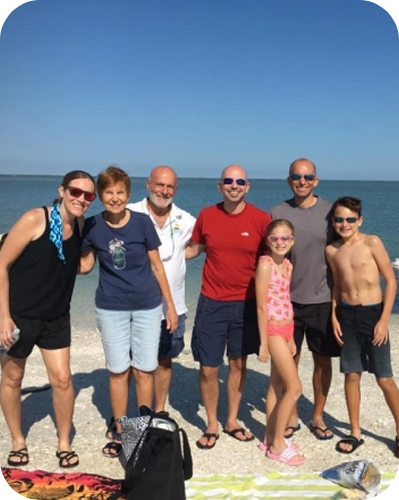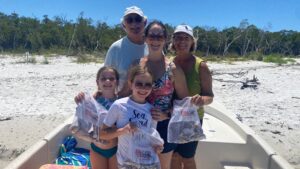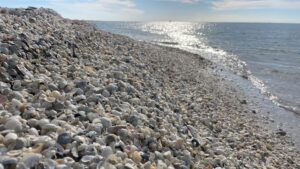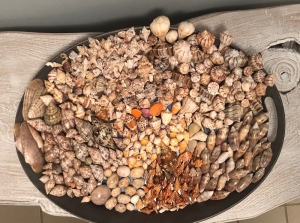It lurks nearly a foot beneath the dunes of Sanibel Island. Its brown spotted exterior provides camouflage, making it a challenge to spot. Though small, this elusive specimen is a rare and valuable jewel, waiting to be discovered.
We’re talking, of course, about the elusive Junonia shell, a rare beauty that you can add to your collection of Florida seashells after a day spent shelling on the beach. Florida is full of unique and gorgeous shells, some of which can only be found in the ten thousand islands region. But how will you know which shell is which after a day spent scouring the beaches?
If you’re curious about the kinds of shells that you might find after an excursion to one of the best seashell beaches in Florida, you’re in luck. Read our Florida seashell identification guide for a list of seashells (including shell names), and to learn about the shells you can find on the beaches of Florida, Marco Island, and Sanibel Island.
Why Should I Go Shelling in Florida?

Shelling is a decades-old activity that is just as fun for kids as it is for adults. Native residents of Florida’s islands have been finding and crafting with seashells for generations. Shelling is essentially an all-natural treasure hunt, with every find being a unique, natural specimen from the ocean.
Beaches are naturally impermanent. They change with the tide and the weather. You cannot walk on the same beach two days in a row, which means the shells that are available to find are constantly in flux.
Florida is unique because it is surrounded by islands, and the shape and location of these islands make them ideal depositories for shells. Two of the best islands for shelling are Sanibel Island and Marco Island. While Sanibel is accessible by a causeway, Marco Island is only accessible by boat.
How Do I Find Shells in Florida?
In some cases, you only need to walk along the coast to find perfect shells washing up on the shore. In other cases, you may need to put a little work in and do some digging. The rare Junonia is one such shell that might involve a little work.
If you’re hoping for rare shells, it’s wise to go shelling with a guide. An experienced sheller can use what they know about science to help you locate rare and beautiful shells. The locals are experts!
If you want to improve your odds, one tip is to set out early in the morning, especially during low tide or after a storm. Summer is the best season for this. Plan to go to more than one beach to find the widest selection, or choose a secluded island, such as Marco Island.
What Types of Seashells Can I Find in Florida?
On the abstract, there are two basic types of shells that you are likely to find while out on a shelling excursion in Florida. These types are bivalve shells and gastropod shells. Seashell identification and seashell classification become easier when you sort them into these categories first.
BOOK YOUR SHELLING TOUR!
Are You Looking For A Guided Seashell Finding Tour in Southwest Florida? Book With Sand Dollar Shelling!
Types of Seashells: Bivalve Shells

Bivalve shells are single shells with two parts. Each part is considered a valve, which is why we call them bivalves! A clam shell is the most common example, but cockles and scallops also live inside of bivalve shells.
When bivalve shells wash up on beaches, it’s common to find only one-half of the shell. While it’s rarer to find both halves still attached, it’s not impossible. Usually, both halves are symmetrical, if not identical.
Bivalve shells tend to be common on Florida beaches, but they are no less beautiful or exciting to find!
Types of Seashells: Gastropod Shells
Gastropod shells are also single shells, but they do not have two parts. When you find a gastropod shell, you have always found the complete shell. The most traditional example of a gastropod shell is a conch shell, but whelks also commonly live in gastropod shells.
Gastropod shells are typically home to snails. When you find one, it’s important to check and make sure that it is not occupied by a living (or recently deceased) snail!
These shells come in three typical shapes: oblong, globose, and depressed. In simpler terms, gastropod shells can be long and thin, round and spherical, or round and flat. No matter the shape, they are all beautiful and unique treasures!
Gastropod shells tend to be rarer, so you may need to consult
Florida Seashell Identification Guide
Now that you’re familiar with the basics of shelling, and can categorize shells into broader categories, it’s time to get specific. The following Florida Shell Identification guide will teach you about the rare and prized shells you are likely to find on Florida’s beaches if you are patient!
Seashell names (specifically, types of shells in Florida) will be listed below. This guide will also help with rare seashell identification.
Junonia Shells

Junonia shells are some of the rarest types of shells in Florida, but they’re out there! When identifying seashells that you think might be Junonia, look for an off-white, oblong gastropod shell with brown spots that look like watercolor paint. This shell houses a yellow, spotted snail that lives deep on the ocean floor, which is part of what makes the shell so rare.
These shells are typically small, which makes them challenging to spot when they do wash up. The largest recorded Junonia shell was only six inches long, and most are considerably smaller!
These shells are also fragile and do tend to wash up on the shore in pieces. If you have found an intact Junonia shell, you have had some great luck!
Murex Shells
The Murex shell is distinctive, with a white and pink exterior. You can tell these Florida shells by their spikes, tail, and pleasant pink interior. They are gastropod shells, each with a unique shape.
These shells are home to the Murex snail, also known as the rock snail. These are some of the oldest seashells, having been named by the ancient Greek philosopher Aristotle!
These shells are very delicate, due to their unique spikes. As a result, you would be lucky to find one with the spikes intact. More often than not, they break off before reaching the shore.
Conch Shells
The Conch is another rare and beautiful gastropod shell found in Florida. Conch shells are medium to large in size and can be identified by their two distinct points. It is difficult to identify a shell by color, as they tend to be unique.
The Conch shell is home to a variety of different sea snails. Conchs are a little more ambiguous, as the word “conch” itself comes from the Latin and Greek for “Shellfish.”
Sand Dollar Shells
Sand dollars are incredibly distinctive, with a thin, flat, circular shape and a five-pointed star shape imprinted on top. After exposure to the sun, sand dollars become bleached. This creates a pristine white color.
Sand dollars are actually a kind of sea urchin! They are just as flat when they’re alive, and burrow on the ocean floor.
Worm Snail Shells
If you’ve found something that looks like a piece of spiral pasta that has washed up on the beach, you probably have a worm snail shell. These gastropod shells are known for their distinctive thin, spiral shape, which ends in a pointed tip.
The worm snail that makes its home out of these shells is also known as a Vermetidae. A large enough collection of these worm tubes can form a sponge colony, and create a coral reef!
Lightning Whelk Shells
The lightning whelk is the state shell of Texas, but it can still be found washing up on Florida’s beaches. These gastropod shells can grow to be quite large, with the largest specimens measured at sixteen inches! They tend to be yellow, grey, white, or tan with a left-handed tail.
These shells are home to predatory sea snails. Early Island natives have used these shells to create lamps and tools.
Florida Spiny Jewelbox Shells
The Florida Spiny Jewelbox is also known as Arcinella cornuta. It is a bivalve shell that is home to a clam. It is a thick, heavy, white shell with a pink or red interior that can be identified by its tows of pleated ribs.
These shells are predominantly found along Florida’s coast. They make their home in the local coral reefs. You are unlikely to find this unique shell anywhere else in the world!
Coquinas Shells
Coquinas shells are tiny bivalve shells that come in a wide range of colors and patterns. Most coquinas shells are no bigger than a dime! You need to be careful when gathering these shells, as their size makes them more likely to wash up on shore alive.
Coquins shells can be blue, pink, purple, orange, brown, or some combination. It’s their unique coloration that makes these little shells such treasures.
Jingle Shells
It’s easy to distinguish a jingle shell by its paper-like translucence. Jingle shells are named for the sound they make when shaken, and come in a range of colors.
They tend to have a wrinkled texture and a pleasant, almost polished sheen. Because of the way they look, they are sometimes known as “Mermaid’s toenails.”
Olive Shells
Olive shells come in an elongated oval shape and tend to bleach white in the sun. They have a distinctive stepped spire. These petite shells are shiny and rarely grow larger than about three inches.
They are home to the olive snail, which is a sea snail that is common in the Floridian waters.
Calico Scallop Shells
These fan-shaped bivalve shells come in a diverse assortment of colors and patterns. They can be distinguished by their radial fluted ridges. They are brightly colored, and no two Calico Scallops look alike!
Spotted Slipper Shells
Spotted slipper shells are sometimes called boat shells because, when held upside down, they resemble tiny, flat-decked ships. They also look a little bit like a slipper! They are white shells with unique brown colored streaks.
These shells are home to the spotted slipper snail and don’t grow much larger than two inches. A unique facet of these shells is that, after two years of floating, they can attach to other empty shells. A cluster of spotted slippers is a unique find!
Cockle Shells
A cockle shell is a bivalve shell, and one of the most common finds on Florida beaches. They can be confused for scallop shells, but are actually home to a unique mollusk called a cockle. A true cockle has a heart-shaped shell that is rounded on the top.
These common shells can grow to be fairly big, and a large, intact cockle shell is an exciting find for any collector!
Keyhole Limpet Shells
A keyhole limpet shell can be distinguished by its conical shape and keyhole ‘opening’ at the very top, with radial ridges. When the limpet is alive, the hole is how waste and water exit the shell.
Limpets are fans of rocky shores and are fairly common in North America. There are 35 different species of limpet in North America, and many of them make their home in the south Atlantic!
Tulip Banded Shells
The banded tulip shell is a spindle-shaped ivory or gray gastropod shell with swirling brown bands or stripes. Some tulip shells can grow quite large, and are an exciting find for collectors!
Turkey Wing Shells
These shells can be distinguished by their unusual “turkey wing” shape, which looks like the outstretched wing of a bird. They have interesting curves, but one side of a turkey wing shell is often completely straight. These shells tend to have rows of swirling brown stripes that form unique patterns.
These shells are home to the turkey wing arc clam, also known as a zebra clam, due to the stripes. If you have found a clam that looks like a cross between a turkey and a zebra, it’s most likely a turkey wing shell!
Wentletraps Shells
Wentletrap shells are also known as staircase or ladder shells because of their delicate and unique structure. These gastropod shells are white and polished, similar to porcelain. They almost always have a high, pointed spire.
Wentletrap shells are home to a very small parasitic marine snail. As a result, these shells can be tiny! These shells were once very rare, but a patient sheller can find them on Florida beaches!
Ceriths Shells
Ceriths shells are small gastropod shells, rarely larger than an inch in size. They are narrow, spired shells, often with a brown striping pattern. They are also known as horned shells.
Ready to Go Shelling?
Florida beaches are beautiful year-round, and it’s never a bad time to search for Florida Seashells on Marco Island. If you’re ready for a rewarding natural treasure hunt, the seashell guide above will definitely get you started!
If you want an in-person guide, book a tour with Captain Joey at Sand Dollar Shelling. More than just a boat taxi, you can enjoy a guided shelling adventure on one of Florida’s most pristine shelling beaches!

